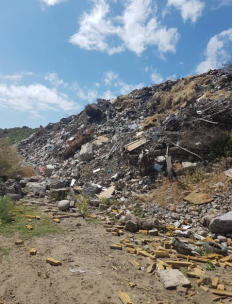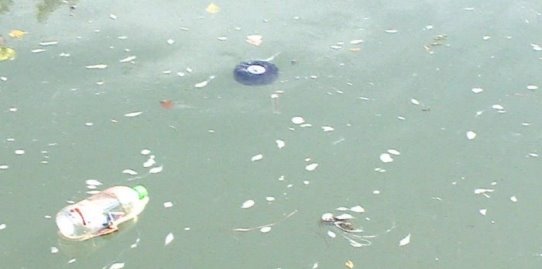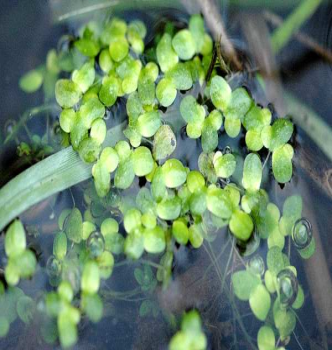
Nowadays some countries face the problem of fresh water, and Uzbekistan is not an exclusion. This problem concerns the pollution, depletion, water poisoning, various illnesses and other problems in our freshwater sources. We can see it by the example of the Chirchiq River. The Chirchiq River rises in the Charvak reservoir and disembogues its waters into the Syr Darya near Chinaz. Its length is 154 kilometers, the area of the basin is 14 240 square kilometers. The Chirchiq is a rapid mountainous river; its deep, narrow part flows rapidly. The Chirchiq River becomes wider behind the waters meet with the Ugam River. A row of tributaries disembogues into the Chirchiq River. The largest of them are the Ugum River and the Aksakatasay River. The water consumption is 221 m3 per second near the village of Xujakent, and it is 62 m3 per second near Chinaz. However, garbage covers the Chirchiq River near the Sergeli district, and it causes an extensive waterlogging of its flow, and especially the harm to the ecological and freshwater resources. In addition to deteriorating of the natural state of the water, it also causes the change in speed and route of water flowing. Therefore, the Chirchiq River is not only the source of irrigation of orchards and crops, but also the major problem for farmers and other users of the water system. Where do these problems come from and why? Blocking some part of the water near the exhibition area, the Chirchiq River flip over the garbage. According to the words of local residents, the construction waste is then being dismantled, which results in slight reduction in water flow and quality of water. Now the tasks we are facing are much more complicated, and the cleaning work divides into several steps. Irrigated soils have unique properties. The high irrigation rate (1200 m3 per hectare) leads to the excessive removal of salts from the soil and contamination of plants, because the groundwater level is much higher in saline soils. Most of halophyte plants require sufficient moistening of the soil, such as macro-plants, sprouting and flowering. Therefore, the sufficient moisture content of the soil surface (from 10 to 40 cm) will ensure their rapid growth and development. When creating such a favorable environment, it is desirable to reduce the irrigation rate and to increase the amount of irrigation. It is desirable to use 400-500 m3 per hectare of irrigation water and to increase the number of irrigation water to 5-6 times in order to obtain the harvested fodder crops, such as calendula, citron, leek and seed. It is enough to spend 2400-3000 m3 of water per hectare for the whole plantation season. These usual cultivated plants (e.g. corn, oats, etc.) are twice less than the rates of irrigation.
Today many countries in the world face the fresh water problems, and our country is not an exclusion. These problems concern the environmental pollution and reduction of our water resources. The history of the Great Fergana Canal, which is located in the Fergana region, is colossal and astonishing for all of us, because it is the largest hydroelectric power plant in the Fergana valley, which laying took less than two months. It began on August 1, 1939, and the work was finished in 45 days. Indeed, people laid the canals from ancient times to get the water necessary for life and land cultivation. The residents of Fergana region were always engaged in farming, but because of the shortages of water and lack of irrigation facilities, the fertile lands became desert. The laying of the Great Fergana Canal satisfied the needs of people in fertile lands, and allowed creating the gardens and vineyards.
A year later, in 1940, the Great Fergana Canal was extended in Tajikistan. 180 thousand workers, peasants, about three thousand engineers and technicians took part in the national building project. The extension of the Canal created new opportunities for land cultivation, provided with water supply of 500 thousand hectares of irrigated land in Uzbekistan, Kyrgyzstan and Tajikistan.

Do we preserve the Great Fergana canal, which we inherited from our ancestors? Do we esteem their efforts?
On looking at the Canal, we witness the leakage of water. This is not just a spontaneous waste, it is the rubbish thrown by the residents of the surrounding area.

At this point, we ask the right questions. The district repository did not allocate any waste dump to a residential area around the canal, so the residents dump the waste into the canal that results in the pollution of the environment in general. It is important to consult the Office for solution of the problem. In addition, it is necessary to assume different measures and educate the population about the environmental protection. It is essential that in the villages near the canal, there will be more garbage-removal trucks in operation.
The Canal can be used for irrigation in three regions in Uzbekistan (66.6 thousand hectares in Andijan region, 12 thousand hectares in Namangan region and 125 thousand hectares in Fergana region). The total area of irrigated arable land is thus 204.6 thousand hectares. We know that we need to increase the fertility of the land in our own country, but we also know that it is necessary to carry out the above-mentioned tasks practically without polluting the Fergana Canal.
The water and environmental benefits of the work are evident.
Surveys around the Chirchiq River and its floodplains, which were conducted by the sanitary-hygienic personnel, revealed that infectious diseases did not spread or spread in the populated localities. All the cases of disease spread were reported to the Ministry of Health and all the patients got the correspond help.
The aquatic plant Lemna Minor could be used for the biological reduction of the mineralization of Chirchiq River in Tashkent region that could result in its turn in the appearance of the possibility of water usage of the above-mentioned river within the irrigated agriculture.

The vegetative body of the Lemna minor is 2-4.5 (Zhdanow, 1981); very rarely, it can be equal to 10 mm. In length it is between (0.6)2-3(5) mm (Landolt, 1986). The amount of leaf ribs is varies from three to five; the leaf itself is flat, rather thick, green from above and yellow or white-green from below, rarely the red spots can also be found on the bottom. The largest air cavity is rarely reach more than 0.3 mm. The bottom side of leaves plays the main role in the absorption of minerals, whereas the root keeps the plant on the surface of the water. The tip of the root is encased in a cover of round shape. The Lemna minor blossoms in autumn, proliferates rather rarely. However, in some places where the population is unclear, sometimes the flowering process is accelerating and developing.
Summary
According to the statistical data, the average human life expectancy is 68-75 years. However, for some short-lived individuals, nature is worse than ever before.
The purpose of the article was to clean the stream of water, known as the Chirchiq River, to provide the residents living near the river with clean drinking, as well as to provide the water for irrigation for farmers. We used the Lemna minor to reduce the collector drainage through the biological technology, and we managed to restore the semi-contaminated water with the help of this plant. This, in turn, contributed to the increase of both the quality of water used for farming and quality of fertilizers. Of course, I think that all this will become another step in the further improvement of the water management and reclamation status of the Republic of Uzbekistan.
References
1. IA Grudzinskaya. The arum family (Araceae). In: AL Takhtadzhyan. Plant life: Flowering plants. Moscow: Publishing house “Prosvescheniye”; 1982. p. 493-500.
2. IA Gubanov. 306. Lemna minor L. In: Illustrated guide to plants of central part of Russia. Moscow: Publishing house of the Institute of engineering studies; 2002. p. 409.
3. OI Kuzeneva. Lemna. In: Flora of the USSR. Edited by VL Komarov. Moscow:
Publishing house of the Academy of Sciences of the USSR; 1935.
4. VP Makhlayuk. Medical plants in alternative medicine. Saratov; 1967.
5. E Landolt. The family of Lemnaceae (monography). Veröff. Gebot. Isnt. ETH (Stift. Rübel); 1986. p. 481.
6. Lemna minor. www.cate-araceae.org
7. MB Tsirling. Aquarium and water plants. Saint Petersburg: Publishing house “Hydrometeoizdat”; 1991.
8. VS Zhdanov. Aquarian plants. Moscow: Publishing house “Lesnaya Promyshlennost”; 1981.







